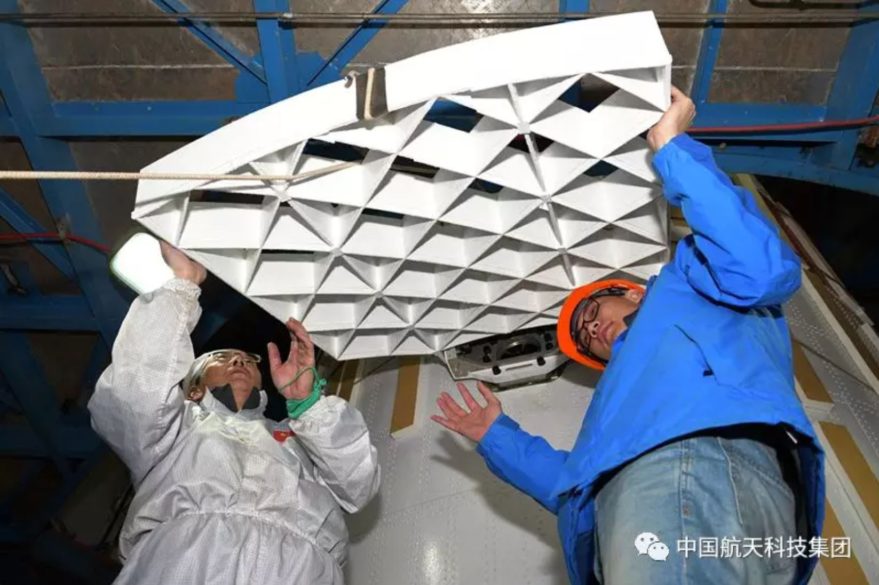TAMPERE, Finland — A Chinese Long March 4B delivered an Earth observation into orbit satellite late Saturday, with grid fins guiding the descent of the rocket’s first stage.
The launch took place at 11:22 p.m. at the Taiyuan Satellite Launch Center in north China. For the first time the Long March 4B first stage carried a grid fin system to constrain the area in which it falls.
Most of China’s launches take place at thee centers far inland, resulting in debris landing downrange. The grid fins are to both reducing risk and mark a step toward future retropropulsive landings and launcher reusability.
Both the launch and the test of the grid fin system were declared successful, with the first stage falling within the designated area.
The main payload for the mission was the Gaofen-7 optical Earth observation satellite, sent into a 489 by 528-kilometer orbit inclined by 97.5 degrees.
Gaofen-7 is designed to obtain high resolution optical 3D observation data and high-precision laser altimetry. Gaofen satellites are part of the civilian China High-resolution Earth Observation System.
Iodine propulsion, Sudan in orbit
Joining the main Gaofen-7 payload were two small satellites and a CubeSat. The Sudan Remote Sensing Satellite was developed by Shenzhen Aerospace Dongfanghong HIT Satellite Ltd. Huangpu-1, a technology demonstration satellite, was developed under the Shanghai Institute of Satellite Engineering.
The final passenger was developed by Spacety, a privately-owned Chinese satellite manufacturer based in Changsha. The 6U CubeSat is a technology test for multispectral imaging.
The Dianfeng spacecraft also carries a 0.4 kilogram laser communication payload from LaserFleet for technology verification tests. LaserFleet is a spin-off from the Chinese Academy of Sciences (CAS) with plans to build a low Earth orbit constellation providing broadband services that through laser communications.
The satellite includes an Iodine-based propulsion system developed and built by ThrustMe, a French company founded in 2017. The system a first-of-its-kind, non-pressurized, cold gas thruster fuelled by solid iodine, according to a ThrustMe press release.
Grid fins for debris, reusability
The hypergolic Long March 4B is designed and manufactured by the Shanghai Academy of Spaceflight Technology (SAST). It is also developing a new variant of its new generation Long March 6 kerolox launcher. Utilizing landing legs and grid fins it will be capable of Falcon 9-style vertical takeoff and vertical landing.
The China Academy of Launch Vehicle Technology (CALT) tested grid fins on a Long March 2C in July. CALT is developing its own retropropulsive landing capabilities for use on the planned Long March 8.
SAST and CALT are subsidiaries of the China Aerospace Science and Technology Corporation (CASC), China’s main space contractor.
In 2017 CASC released a space transportation roadmap, outlining ambitions to make its launch vehicles fully reusable by 2035.

Earth observation system, launch cadence
China now has 14 Gaofen satellites in orbit forming a civilian Earth observation constellation. These provide panchromatic, multispectral and synthetic aperture radar imagery.
Unlike other satellites nominally included in the series, specifications for Gaofen-11, launched in July 2018, have not been released. Computer generated renders of the spacecraft on-orbit suggest a large aperture high resolution Earth observation satellite with resemblance to U.S. Keyhole-class satellites.
The Nov. 2 launch was China’s 23rd of 2019, including two launch failures and a communications satellite stuck in geosynchronous transfer orbit. A Long March 3B launch of a Beidou navigation satellite could take place Monday from Xichang, despite an absence of airspace closure notifications.
Launch of a commercial Kuaizhou-1A solid rocket was scrubbed last week but is expected to launch in the coming days. Aboard will be a Jilin-1 high resolution commercial remote sensing satellite. This will be followed days later by a further Kuaizhou-1A launch from Jiuquan carrying small satellites for CAS.
#Space | https://sciencespies.com/space/china-tests-grid-fins-with-launch-of-gaofen-7-imaging-satellite/
No comments:
Post a Comment